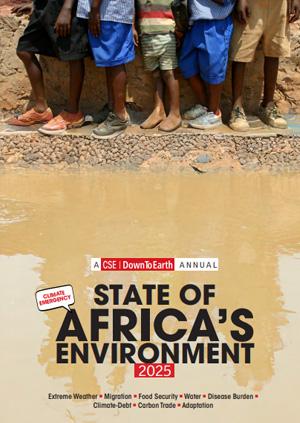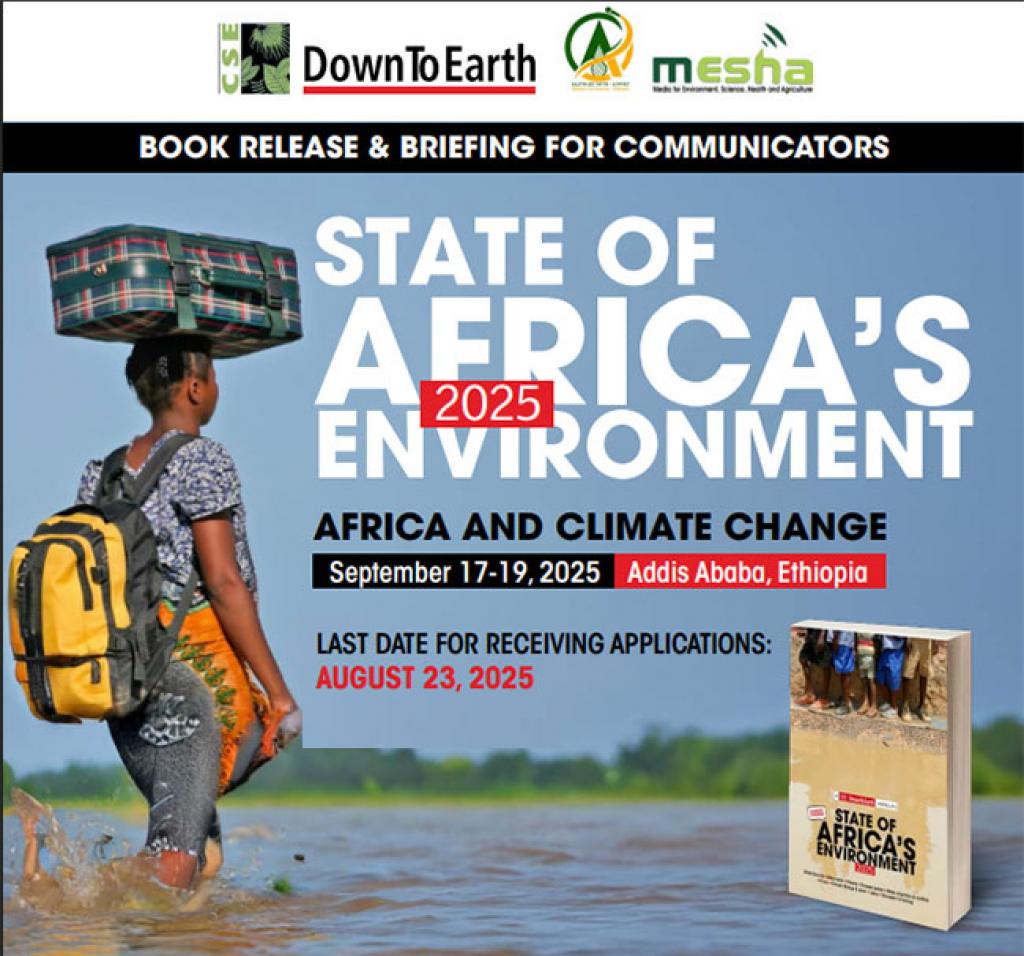Africa is warming more rapidly than the global average, says CSE’s State of Africa’s Environment report, released in Addis Ababa today
Africa would have the highest rate of displacement or migration due to impacts of climate change – says the report. Between 2021 and 2025, nearly 222 million people have been affected by weather, climate and water-related disasters
Alliance for Science-Ethiopia, Centre for Science and Environment (CSE), India, Down To Earth magazine, and Media for Environment, Science, Health and Agriculture (MESHA), Kenya jointly release the 2025 annual report on the state of environment and development in Africa, at a communicator’s and mediaperson’s briefing in Addis Ababa
Professor Kassahun Tesfaye, Director General, Bio and Emerging Technology Institute, Ministry of Innovation and Technology, Government of Ethiopia; Nigussu Lema, Deputy Director General, Ethiopian Environment Protection Authority; Dr Rita Bissoonauth, UNESCO-Director of Addis Ababa Liasion Office to the AU and UNECA and Representative in Ethiopia; and Sunita Narain, Director General, CSE were the chief guests at the inaugural session
Free download of the report click here
Addis Ababa, September 18, 2025: The year 2024 was the warmest year on record for Africa. To add to this, almost the entire ocean area around the continent has been reeling under marine heat waves – says an annual report on the State of Africa’s Environment that was released here today. “The period between 2021 and 2025 has been the most devastating five-year stretch in terms of human toll from weather, climate and water-related disasters”: adds the report.
Researched on and published by New Delhi (India)-based fortnightly Down To Earth and the research and advocacy body Centre for Science and Environment (CSE), based on investigative reportage by African journalists from across the continent, the State of Africa’s Environment 2025 covers subjects ranging from adaptation, carbon markets and climate debt, to migration, food security, water and health. The report was released at a communicator’s and journalist’s briefing organised jointly by CSE and its partners in Africa, the Alliance for Science-Ethiopia and the Media for Environment, Science, Health and Agriculture (MESHA), Kenya.
The report presents a set of thoroughly researched and analysed data. Climate-induced migration, for instance, is a matter of concern. By 2050, says the report, up to 5 per cent of Africa’s population of some two billion people could be forced to be on the move due to climate change. “Africa, in fact, would have the highest rate of displacement or migration due to impacts of climate change,” says the report.
Food insecurity is looming. Climate change, combined with land degradation, is causing an 18 per cent decline in agricultural production. In fact, the report points out that cocoa production in West and Central Africa (which produces 70 per cent of the world’s cocoa) would be severely hit. If the world warms up to 2oC, it would put 50 per cent of the continent’s population at risk of undernourishment.
In terms of health, the report points out that the global burden of cholera has shifted to Africa – there was a 125 per cent increase in cases in 2023 compared to the previous year. There was a 14 per cent rise in malaria transmissions as well in the same year.
Speaking at the launch of the report, Professor Kassahun Tesfaye, Director General, Bio and Emerging Technology Institute, Ministry of Innovation and Technology, Government of Ethiopia, said: “The data in this report, while alarming, also points the way forward. It shows that our greatest liability – our natural resources and land – is our most powerful asset to build a sustainable bioeconomy. The solution lies in not simply trying to mitigate a crisis we did not create, but in pioneering a new model of development altogether – that model is the African bioeconomy.”
Explaining what he meant by ‘bioeconomy’, Professor Kassahun said: “This is an economic system that uses renewable biological resources to produce food, materials and energy. It is a circular economy where waste is not an endpoint but a new beginning. It is an economy that is inherently sustainable, regenerative and tailored to our continent’s strengths.”
In her address, CSE Director General Sunita Narain said: “Change is taking shape in Africa. Across the continent, countries are adopting policy measures and crafting programmes to adapt to and mitigate climate change. Starting from rolling out a national strategy to become net-zero in carbon emissions to adopting indigenous knowledge to fight impacts such as drought and extreme weather events, every African nation now has some adaptation programmes to showcase.
Addressing the assembled audience, UNESCO’s Dr Rita Bissoonauth said: “This report from CSE is more than a scientific assessment. It is a moral compass. It comes at a pivotal moment. Africa is on the frontline of a climate emergency it did not create. Estimated average direct economic losses are to the tune of US $1.18 billion per year in northern Africa and US $1.25 billion per year in sub-Saharan Africa. The message of the 2025 State of Africa’s Environment report is clear – the current trajectory is not sustainable.”
Highlighting the steps taken by Ethiopia, Nigussu Lema, Deputy Director General of the Ethiopian Environment Protection Authority, said: “Ethiopia’s climate adaptation efforts focus on strengthening climate resilience through its National Adaptation Plan (NAP-ETH), which integrates adaptation into its development strategies.”
The communicator’s and journalist’s briefing will continue till September 19, 2025, and will cover three subjects – conflicts, migration and climate change; agriculture, food security and climate change; and adaptation. About 20 journalists from across Africa are participating.
If you have questions or need more details, please contact Sukanya Nair of The CSE Media Resource Centre: sukanya.nair@cseindia.org, 8816818864.
*-




Share this article